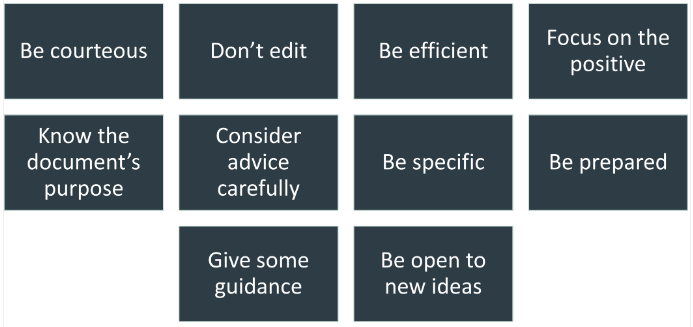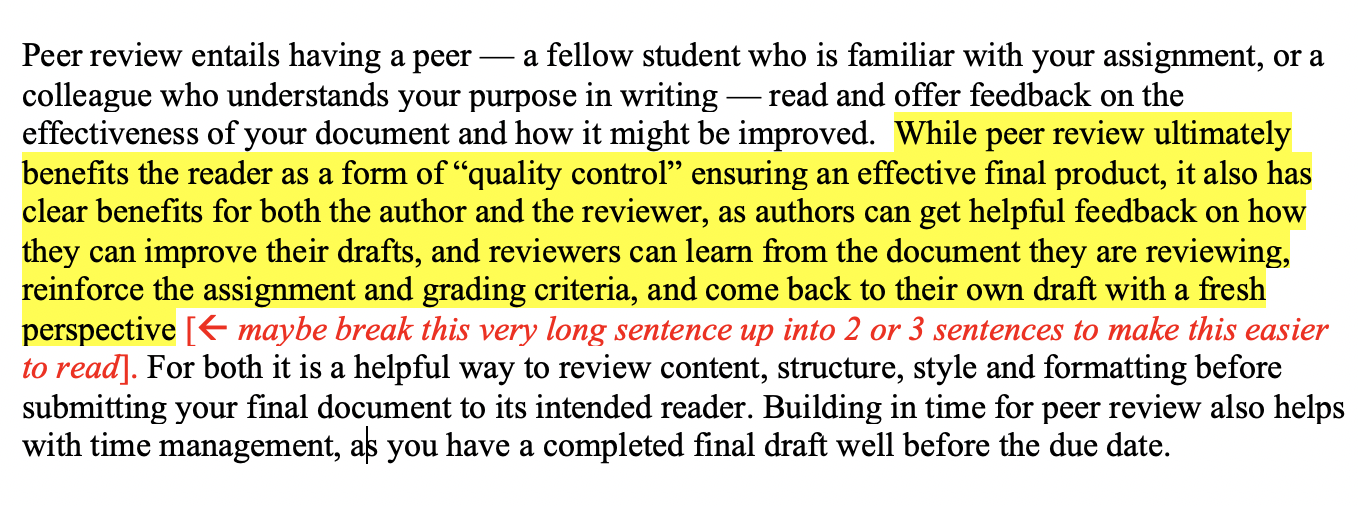Appendix H: Peer Review Essentials
Peer review entails having a peer — a fellow student who is familiar with your assignment, or a colleague who understands your purpose in writing — read and offer feedback on the effectiveness of your document and how it might be improved. While peer review ultimately benefits the reader as a form of “quality control” ensuring an effective final product, it also has clear benefits for both the author and the reviewer. In the process of peer review, authors can get helpful feedback on how they can improve their drafts, and reviewers can learn from the document they are reviewing, reinforce the assignment and grading criteria, and come back to their own draft with a fresh perspective. For both it is a helpful way to review content, structure, style and formatting before submitting your final document to its intended reader. Building in time for peer review also helps with time management, as you have a completed final draft well before the due date.
In order to attain the maximum benefits of Peer Review, both authors and reviewers should keep the following strategies in mind:
Author Strategies
- Be prepared: submit the most polished and complete draft possible in order to fully benefit from peer review. A partial or very rough draft can benefit from some preliminary review, but a completed draft can elicit more helpful feedback.
- Give reviewer some guidance: describe the concerns you have about your paper at this point. Alert your reviewer to areas where you would particularly like some feedback. If the reviewer is not familiar with your purpose and audience, fill them in.
- Be open to new ideas: avoid becoming defensive about the feedback; remember, your reviewer is trying help you improve your draft. Consider alternative viewpoints you may not have thought of before; listen before deciding what you will do.
- Consider advice carefully: think critically about whether the reviewer’s suggestions will help you to improve your draft and if they are appropriate for your purpose and audience. What and how you revise is ultimately up to you; take your reviewer’s advice with a grain of salt, and seek additional advice if you are unsure what to do.
Reviewer Strategies
- Know the document’s purpose: review the assignment description and/or grading rubric before reviewing the draft; know what the paper is trying to achieve before you assess whether it needs revision to achieve it.
- Focus on the positive: be honest and critical, but also point out strong areas within the writing where things are working well. Use positive, constructive tone to discuss areas that could use improvement. Don’t gush (“your paper is so awesome!”) and don’t trash (“This totally sucks! Rewrite the whole thing!”). Remember your purpose is to help the author find ways to improve the draft; recognize what is already good, and suggest what needs further work.
- Be specific: explain why a sentence, paragraph, or image needs improvement; explain why you as the reader are confused or bothered by a specific phrase or passage, or why the logic does not flow for you (be “reader centred”).
- Be courteous: be aware of your language use and tone when addressing peers. Avoid patronizing or “talking down” to your peers when giving advice.
- Don’t edit: Your job is reviewer, not editor. Don’t fix errors or phrasing problems; just point out areas that need improvement. You might offer ONE sample correction to demonstrate what you mean, but do not engage in wholesale editing. The purpose of peer review is for each person to learn how to edit their own document based on reviewer feedback.
- Be efficient: don’t overwhelm your author with too much detailed feedback. A page that has more feedback notes than content will be very difficult to process. Focus on a handful (3-6?) of the most important revisions that are needed to help improve the draft. For example, if there are numerous spelling errors, don’t point them all out; highlight one or two and then comment that the draft contains numerous spelling errors that will need fixing before it can be submitted.
Test your knowledge of the strategies above.
H5P: Author and Reviewer Strategies
Based on the information in this section, choose all of the reviewer strategies. *Some may apply to both but choose the ones specifically listed in this section.

Methods of giving feedback
There are many ways to provide feedback on someone’s work; how you do this will depend on what form of work you are reviewing, the context, and the situation. For example, if you are doing a peer review in a classroom with your peer groups face-to-face, you might give feedback verbally, or you might put hand-written feedback on their papers. In some cases, your instructor might give you a checklist to use, which you must fill out as you are reading your peer’s draft.
If working remotely, you might read your peer’s work as an online post, and post a reply in which you write out all your feedback within the reply window, like the one below.

To offer more detailed feedback, you might download the author’s document and write inline comments on the draft – ideally using a different colour to make your comments standout more easily, as seen below.

Then upload your revised document as a reply to the author. Inline comments can affect the formatting of the document, so you may instead want to use the “insert comment” function.
 This will allow the document formatting to remain stable, and your comments can be easily deleted after reading.
This will allow the document formatting to remain stable, and your comments can be easily deleted after reading.
However you give feedback, keep in mind these essential guidelines:
- Be specific: give the author specific examples and details; avoid vague or overly general statements
- Be constructive: try to help the author improve the quality of their work in substantial ways
- Be courteous: remember the golden rule, and give feedback in a way that you would like to receive it yourself.

